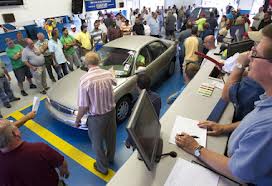Millions of homeowners have lost their homes to foreclosure. According to Realty Trac, 2.8 million households faced foreclosure in 2009, and the numbers are expected to rise to approximately 3 to 3.5 million homes for 2010. High unemployment rates are contributing to many homeowners defaulting on their mortgages. More than 315,000 households received a foreclosure notice in January 2010 per Realty Trac, down nearly 10 percent from 349,000 in December 2009. That equals to one in every 409 homes being sent a foreclosure notice of some sort. Lenders repossessed approximately 87,000 homes during January 2010, down 5 percent from December. However the numbers are still 31% higher than January 2009.
There are several government foreclosure prevention programs available to distressed homeowners that can help save their homes from going to foreclosure. In fact, there are many more foreclosure prevention options available to homeowners than there were six months ago. Here are some options homeowners may want to consider:
Refinancing
If you have some equity in your home, refinancing is a good option. For homeowners who don’t have enough equity to refinance under traditional refinance programs, the government’s Home Affordable Refinance Program may be the answer for your situation. Homeowners are allowed to refinance with debt that exceeds their home value by 5%. The good thing is there are no prepayment penalties. However, if your home value has declined under 5% and/or you have a jumbo mortgage exceeding $417,000 you won’t qualify under this program, but there is the Home Affordable Modification Program (HAMP). Under both programs, homeowners must show sufficient income to make their payments.
For those homeowners with FHA loans, FHA has a program called the Hope for Homeowners Program. You may be eligible to refinance your mortgage to a 30 year fixed insured by FHA. Homeowners must reside in the home as their primary residence, and the borrower may not own an interest in any other property including a second home or investment property. Your mortgage must have originated on or before January 1, 2008, and you must have made at least six payments. In addition, you have to show proof that you can make your mortgage payment. As of March 2008, your total monthly mortgage payments must equal more than 31 percent of your gross monthly income. Borrowers must certify that they have not been convicted of any fraud in the past 10 years, have not default on debts intentionally and did not knowingly or willingly provide false information to obtain a loan. This is a voluntary program so both you and your lender must agree to participate in the program.
Mortgage Modification
Under the government’s Home Affordable Modification Program, distressed homeowners are eligible for a mortgage modification if the home is their primary residence. The government will give lenders and loan servicer’s incentives for working out a modification plan with their borrowers. Keep in mind though that you are only allowed to modify your loan once under this program. If you don’t qualify, you may qualify for a short sale.
Short Sale
The Treasury Department guidelines for short sales are supposed to encourage lenders/loan servicers and borrowers to participate in a successful short sale transaction and in turn the government will provide incentives to lenders and/or loan servicers and borrowers. To qualify under these new guidelines:
- The property must be the home owner’s principal residence.
- The home owner must be delinquent on the mortgage or close to defaulting.
- The loan must have been made before Jan. 1, 2009, and be for less than $729,750.
- The borrowers’ total monthly mortgage payment must exceed 31 percent of their before-tax income.
Under the plan, homeowners will receive $1,500, and mortgage-servicing companies will get $1,000 for each completed short sale. Second lien holders can also receive up to $3,000 if they agree to release their liens. Investors who hold a first mortgage can receive up to $1,000 from the government for allowing the payments. Lenders must fully release the borrower from the debt. So this means that lenders may not obtain deficiency judgments against borrowers.
Other Options
If you don’t qualify for a refinance, mortgage modification or short sale, then here are some other options you may want to look into:
- Selling Your Home
- Reinstatement of your mortgage
- Deed in Lieu of foreclosure
- Forbearance payment plan
- Bankruptcy
With all the government pressure and lenders having too much foreclosure inventory, lenders would much rather work out a solution with you to prevent your home from going to foreclosure. They don’t like suing their customers because they may want to do business with you down the road in the future. The most important thing to remember is to speak to your lender early on and try and work out a solution that works for both of you. You may want to consult with a foreclosure defense attorney as well to find out all your legal options.











